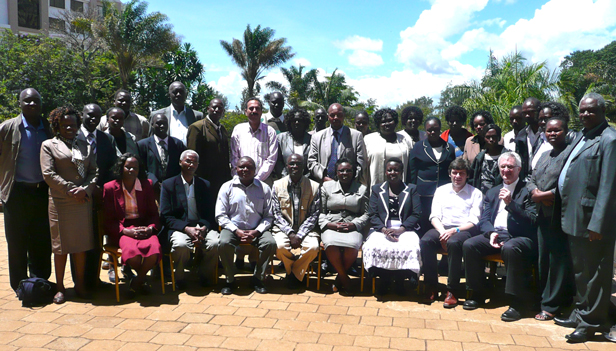MLS 2.1: Kenya-cereals
Abstract/Description (5/2013):
Providing Smallholder farmers to phosphorus fertilizer by improving the trader-farmer interaction
(Version 1*, April 27, 2013)

Many smallholder farmers are facing the problem that they do not know what and how much fertilizers their soil needs for the next crops, that traders do not sufficiently help them to answer this problem and that they do not have the financial means at hand when it is favourable to buy fertilizers. On the other hand traders often do not have neither the knowledge nor the proper fertilizer at hand. The SMAP Kenya project just deals with the farmer-trader interaction and reflects in what way microfinance institutions may help to overcome these deficits.
The SMAP-Kenya case study wants to enhance farmer knowledge on type and amount of fertilizers needed to increase farm yields and hence incomes as well as to improve the interaction between all stakeholders to explore and improve credit and insurance options.
The case study takes place in Uasin Gishu County, which is on of the 47 counties in Kenya. Together with 15 smallholder-farmers, local agro input dealers as well as global phosphorus traders, banks and insurance companies and environmental and farming experts different fertilizer and use scenarios will be explored and the most promising adopted. The farmers’ productivity will then be measured to confirm benefits that farmers gain by adopting improved fertilizer access and use strategies. Economic benefits to other value chain players will also be measured to ensure that all there is sustainability through mutual and shared benefits.
* This is the first version of the description of what will be dealt with in the MLS 2.1 Kenya - Kenya Cereals and provides only a rough description of what will be discussed. A group of practitioners and scientists are currently revising this abstract and composing a booklet which will prepare all participants for the MLS on June 18. Please contact Philip Luthardt, member of the TD Support team or Anh Pallas, Science manager of Global TraPsif you want to join.
More Informations
Executive Summary of DS MLS 2.1 Kenya Serials & MLS 2.5 Vietnam – Urban Agriculture of the 1st Global TraPs World Conference, Beijing 2013 (written 8/2013; released 3/2014)
Preliminary note: No abstract is available for this Dialog Session. The following text comprises the orientations discussed and identified in the joint Mutual Learning 2.1 and 2.2. Philio Luthardt and Rino Mass-Deipenbrock (both MSc. Students at Leuphana University Lüneburg, Germany) facilitated this Dialogue Session of the 1st Global TraPs World Conference, July 18-20, 2013 and are responsible authors of this summary. Twelve people, seven scientists and five practitioners collaborated in this joint session. For further questions, please contact Prof. Ulli Vilsmaier, Leuphana University, Lüneburg (vilsmaier@leuphana.de) or Prof. Roland W. Scholz, Fraunhofer IGB.
Excecutive Summary of MLS 2.1 Kenya & 2.2 Vietnam
During the first Global TraPs World Conference at the 18th June 2013 in Beijing the MLS 2.1 Vietnam and MLS 2.2 Kenya were discussed together, as there are many relations between the two cases, which offer many mutual learning possibilities.
The main problem of both case-studies are the lack of knowledge of the farmers on the one hand and the agro-dealers, who are driven by business. The farmers do not know what type and what amount of fertilizer should they use at what time. In Kenya, when the agro-dealers do not have the correct fertilizer, they sell another one.
The differences between both cases are the financial situations. In Kenya the farmers often do not have sufficient money at the right time to buy the correct fertilizer. Also the agro-dealers do not have sufficient money to stock on several types of fertilizer. In order to receive a loan to buy fertilizer farmers need to have collateral, which is often not the case. Cooperatives could be helpful for this matter. However, most farmers are often skeptical towards this concept.
In Vietnam is financing less of an issue as most of the farmers have arrangements to pay for the fertilizers after the harvest. Generally, p fertilizer is cheap in Vietnam, which also contributes to the overuse. The misconception is often the more fertilizer applied, the better the harvest. Therefore, it is essential in this case to provide soil testing and provide information about adequate fertilizing techniques. Farmers involved in this study divide their land into two parts, where one is fertilized as before and one following the recommendations after soil testing. This provides a control group as well as a direct comparison for the farmer.
As it is the main issue of both cases the participants worked mainly on the question why the yields are declining in Vietnam, with an overuse of fertilizers, and in Kenya, with an underuse of fertilizersquestions how increased fertilization may increase yield under what constraints. The result is, that a clarification system approach, which looks at different components and actors and how they interplay, should be used. In order to not only focus on the issue of fertilizer and ignore related components.
Policy orientations:
- dentifying the sources of declining yields
- Any subsidies should be a kick-starter and not squeeze out other market players
- Transdisciplinary capacity building for the whole value chain: Who could do this sustainably?
- Improving the efficiency of the supply chain
